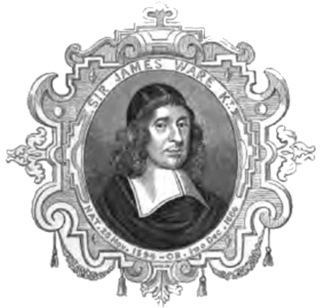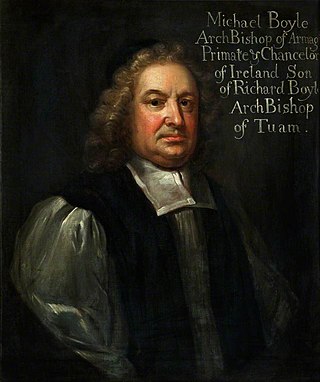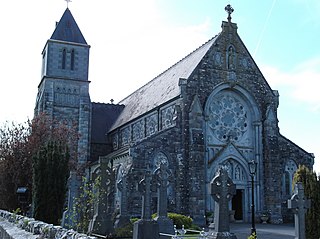
James Ussher was the Church of Ireland Archbishop of Armagh and Primate of All Ireland between 1625 and 1656. He was a prolific scholar and church leader, who today is most famous for his identification of the genuine letters of the church father, Ignatius of Antioch, and for his chronology that sought to establish the time and date of the creation as "the entrance of the night preceding the 23rd day of October... the year before Christ 4004"; that is, around 6 pm on 22 October 4004 BC, per the proleptic Julian calendar.
Adam Loftus, 1st Viscount Loftus, was Lord Chancellor of Ireland from 1619 and from 1622 raised to the peerage of Ireland as Viscount Loftus of Ely, King's County. His uncle, another Adam Loftus, was both Lord Chancellor of Ireland and Church of Ireland primate.
The Lord High Chancellor of Ireland was the highest judicial office in Ireland until the establishment of the Irish Free State in 1922. From 1721 to the end of 1800, it was also the highest political office of the Irish Parliament: the Chancellor was Speaker of the Irish House of Lords. The Lord Chancellor was also Lord Keeper of the Great Seal of Ireland. In all three respects, the office mirrored the Lord High Chancellor of Great Britain.

Thomas FitzGerald, 10th Earl of Kildare, also known as Silken Thomas, was a leading figure in 16th-century Irish history.

Rowland FitzEustace, 1st Baron Portlester was an Irish peer, statesman and judge. He was one of the dominant political figures in late fifteenth-century Ireland, rivalled in influence probably only by his son-in-law Garret FitzGerald, the "Great" Earl of Kildare.

The Lords Justices were deputies who acted collectively in the absence of the chief governor of Ireland as head of the executive branch of the Dublin Castle administration. Lords Justices were sworn in at a meeting of the Privy Council of Ireland.
James Butler, 4th Earl of Ormond was the son of James Butler, 3rd Earl of Ormond. He was called 'The White Earl', and was esteemed for his learning. He was the patron of the Irish literary work, 'The Book of the White Earl'. His career was marked by his long and bitter feud with the Talbot family.

Thomas Jones was Archbishop of Dublin and Lord Chancellor of Ireland. He was also Dean of St. Patrick's Cathedral and Bishop of Meath. He was the patrilineal ancestor of the Viscounts Ranelagh.

Sir James Ware was an Anglo-Irish historian.
John Alen was an English priest and canon lawyer, whose later years were spent in Ireland. He held office as Archbishop of Dublin and Lord Chancellor of Ireland, and was a member of the Privy Council of Ireland. In the latter office, for a few years, he played a central role in the government of Ireland.
Sir Richard Bolton was an English lawyer and judge, who was an important figure in Irish political life in the 1630s and 1640s.

Michael Boyle, the younger was a Church of Ireland bishop who served as Archbishop of Dublin from 1663 to 1679 and Archbishop of Armagh from 1679 to his death. He also served as Lord Chancellor of Ireland, the last time a bishop was appointed to that office.
Robert Weston was an English civil lawyer, who was Dean of the Arches and Lord Chancellor of Ireland in the time of Queen Elizabeth.

Thomas Cantock, Quantock or Cantok was an English-born cleric and judge in medieval Ireland, who held the offices of Bishop of Emly and Lord Chancellor of Ireland.
Sir William Ryves (1570–1647) was a barrister and judge, and a member of a distinguished Dorsetshire family. He enjoyed a successful legal career in Ireland, holding office as Attorney-General for Ireland and as a justice of the Court of King's Bench (Ireland). For a time he acted as Deputy to the Lord Chancellor of Ireland.
Richard Talbot was an English-born statesman and cleric in fifteenth-century Ireland. He was a younger brother of John Talbot, 1st Earl of Shrewsbury. He held the offices of Archbishop of Dublin and Lord Chancellor of Ireland. He was one of the leading political figures in Ireland for more than thirty years, but his career was marked by controversy and frequent conflicts with other statesmen. In particular, the Talbot brothers' quarrel with the powerful Earl of Ormonde was the main cause of the Butler–Talbot feud, which dominated Irish politics for decades, and seriously weakened the authority of the English Crown in Ireland.
Patrick Bermingham (c.1460–1532) was an Irish judge and statesman of the Tudor period who held the offices of Lord Chief Justice of Ireland and Chancellor of the Exchequer of Ireland. He was a firm supporter of English rule in Ireland and enjoyed the confidence of Henry VIII, who regarded him as a mainstay of the Irish administration.

John Methuen (1650–1706) was an English diplomat, judge and Member of Parliament. He held office simultaneously as Lord Chancellor of Ireland and English ambassador to Portugal. In the latter role, he and his son Paul negotiated the Methuen Treaty, the achievement for which John is chiefly remembered.
John Walton was an English canon regular who became Archbishop of Dublin.
Walter Champfleur or de Champfleur was an Irish cleric and judge of the fifteenth century, who played a leading role in Irish politics.








